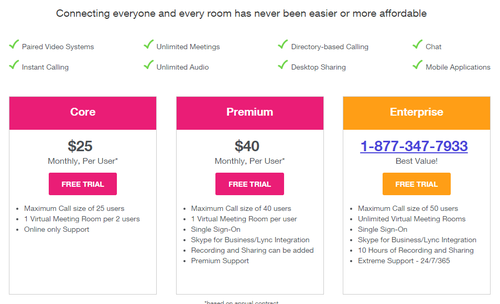CEO Craig Malloy explains the new company’s mission and strategy for the future
I first introduced you to Lifesize in 2007 explaining the company offered near telepresence quality at a fraction of the cost. At the time I said, “The goal of the company is to be the price/performance leader and I can vouch for the quality of their technology as I had a chance to see it for myself.” Two years later, Logitech, excited about the opportunity to move upmarket in the video space, acquired them for $400 million.
The move upmarket: Prior to this acquisition, I had a chance to cover Lifesize as it improved its technology with better quality cameras and other peripherals. These continuous upgrades didn’t stop but over the years, the company realized something important… The video market, like just about all others has moved to the cloud. In an interview with the company’s CEO Craig Malloy (below), he told me they are now a cloud-based meeting platform with connected endpoints.
Spin off justification: According to Malloy, they realized in 2015 that it didn’t make sense to have a B2B SaaS startup in a consumer peripheral hardware company. This is why new investors were needed… $17.5 million in funding has come from three prominent Silicon Valley venture firms – Redpoint Ventures, Sutter Hill Ventures and Meritech Capital Partners. Lifesize has 2,000 paying customers and has slimmed down from 550 to 250 people, a reduction of about 55%.
Craig is so excited by the opportunity, he came back to the company in 2014 to help overhaul it and he thinks they are now well-positioned to compete, win and grow. The spinoff happened as a soft launch late last year and becomes official by the time you read this.
Competition: My natural question at this point is who they see as the competition these days. He said what you might have expected. A few years back, all they saw was Cisco and Polycom – occasionally Vidyo and Avaya. When they became a cloud player, all of this changed. Now he says, they replace companies like GoToMeeting.
In his words, GoToMeeting was popular due to its ease of use, low cost and its ability to give more functionality than a plain phone call. He continued to say, LifeSize gives customers a dramatically better experience. He cites a twelve-year heritage of making conference room devices, connected cameras, corporate directories, meeting rooms, monitoring, management and service as some of the benefits of the Lifesize solution over others – including newer players in the market.
Interop: Since this is a service and endpoint solution, the natural question is whether Lifesize will work only with its own devices. Craig explained they will support H.323 as well as SIP, Skype for Business and WebRTC, meaning lots of devices will continue to function with the Lifesize solution. Still, he said the solution will work best with their own devices from the standpoint of quality, configurability and manageability.
Quality: Certainly, video quality is not lacking based on the conference call I experienced – see photo above which used WebRTC on my end. The sound was clear and the video quality was spectacular. He explained the reason for this is the quality of the camera they use, the image processing pipeline which converts light to analog as well as the compression technology which is powered in-part by a chipset with a decade’s worth of intellectual property. He added the IBM SoftLayer cloud helps power the backend of their solution.
Why upgrade from free? I asked why businesses might want to use his solution instead of something free from Skype or ooVoo. He mentioned customers are becoming comfortable with consumer video thanks to smartphones and they then upgrade to a solution which might have no cost. He added, in a free market, they have to provide demonstrable value, if they expect payment. He went on to say scalability is one of these benefits as they can have 50-way audio/video calls as well as interoperability and guest calling. there is also a management console, user tracking, security with AES encryption, cloud communications instead of P2P like Skype and more.
Conclusion: He said people can use free solutions like a puppy’s free. Perhaps this an expression you’ve heard of… I hadn’t, so it made me laugh and drove the point home nicely that free solutions always come with additional costs you may not be thinking about at the onset.
If you want to learn more, a 14-day trial is free at the company’s site but after that you have to pay of course. Remember the puppy talk from above. The good news is prices start at a reasonable $25 per user and the company is happy to sell to IT as well as individual departments.
Bonus: Spinning off is a very smart move for Lifesize as this is the golden age of cloud video and they do have the backend solutions to differentiate themselves from others. Also a standalone cloud c ompany commands a higher valuation. I predict great success for them and a potential exit to Huawei – unless President Trump (or Sanders) doesn’t let Chinese companies purchase US tech firms – something that’s already been an issue for Huawei in the past. Another logical bidder could be Amazon but since IBM is powering the solution, perhaps Big Blue is more likely to open its wallet. We have some time to see how it all plays out and it should be fun to watch.








